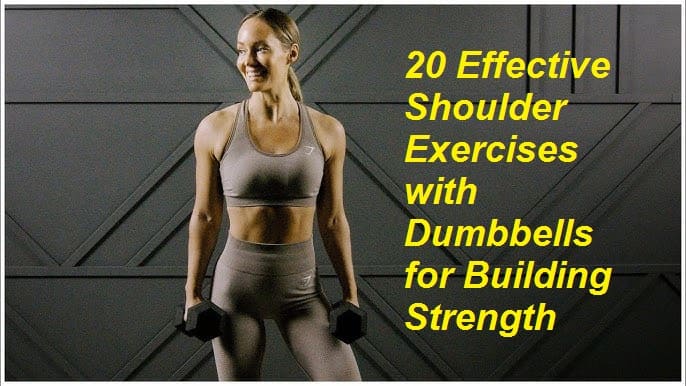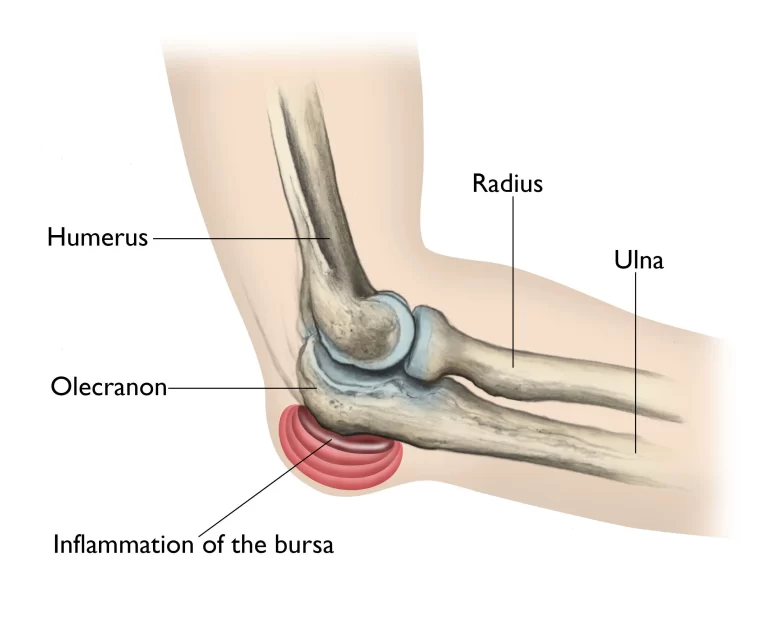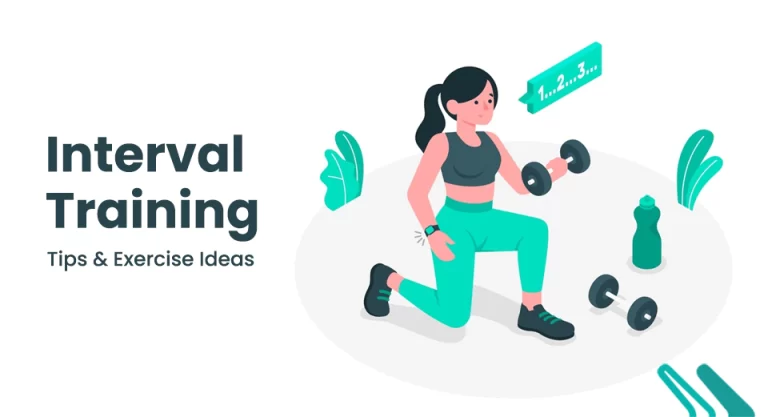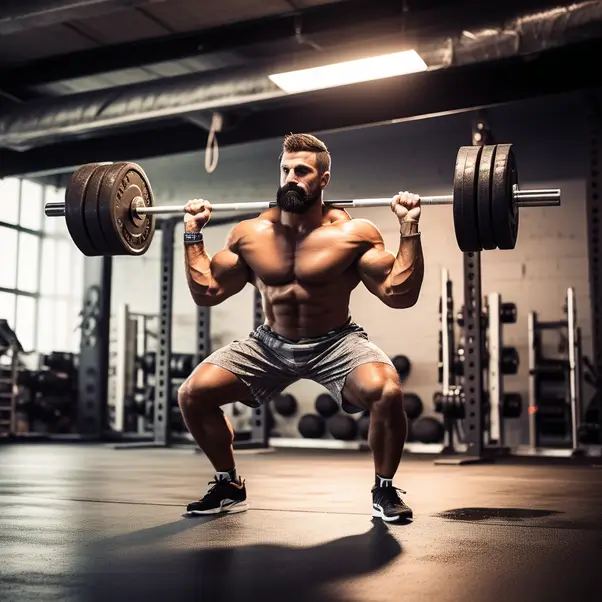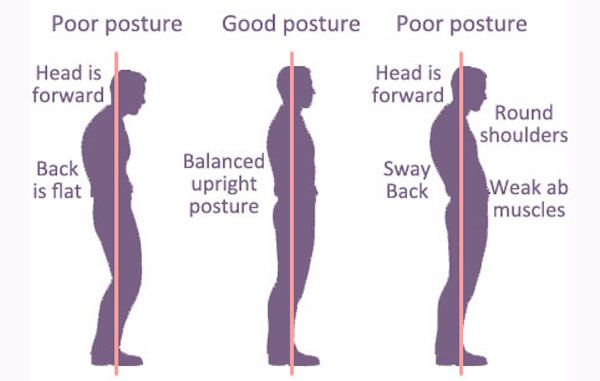20 Effective Shoulder Exercises with Dumbbells for Building Strength
Introduction
Strong, well-defined shoulders not only contribute to a powerful upper body but also enhance overall physique symmetry. When it comes to sculpting impressive shoulder muscles, incorporating dumbbells into your workout routine can yield exceptional results. Dumbbell exercises offer a versatile and accessible way to target various shoulder muscle groups, fostering balanced development and improved stability.
In this article, we’ll explore five highly effective shoulder exercises that leverage the benefits of dumbbells. Whether you’re a fitness enthusiast seeking to enhance your shoulder strength or a beginner looking to build muscle definition, these exercises can be tailored to your fitness level and goals. Incorporating these exercises into your regular workout regimen can help you achieve well-rounded, robust shoulders while also promoting better functional strength for everyday activities.
Get ready to elevate your shoulder training routine with these dynamic and impactful dumbbell exercises, designed to amplify your upper body strength and define your shoulder muscles.
Anatomy of shoulder
The shoulder is a complex joint composed of bones, muscles, tendons, ligaments, and other soft tissues. It allows for a wide range of motion and provides stability to the upper body. The prime components of the shoulder anatomy involve:
- Bones: The shoulder is made up of three bones: the humerus (upper arm bone), the scapula (shoulder blade), and the clavicle (collarbone). These bones form the shoulder joint, with the head of the humerus fitting into a shallow socket on the scapula called the glenoid cavity.
- Joints: The shoulder joint consists of two main joints: the glenohumeral joint and the acromioclavicular joint. The glenohumeral joint is a ball and socket joint with a broad range of motion. The acromioclavicular joint attaches the clavicle to the scapular acromion process.
- Muscles: Several muscles surround and support the shoulder joint, providing movement and stability. The main muscles include the deltoid (located on the outer part of the shoulder), rotator cuff muscles (supraspinatus, infraspinatus, teres minor, and subscapularis), pectoralis major (chest muscle), and trapezius (upper back muscle).
- Tendons: Tendons are strong connective fibers that attach muscles to bones together. In the shoulder, the tendons of the rotator cuff muscles are particularly important for stabilizing and controlling shoulder movements. The most commonly injured tendon in the shoulder is the supraspinatus tendon.
- Ligaments: Ligaments are strong bands of connective tissue that connect bones together, providing stability to joints. In the shoulder, there are several ligaments that help support and reinforce the joint, including the coracoclavicular ligament, coracoacromial ligament, and glenohumeral ligaments.
- Bursae: Bursae are small fluid-filled sacs located between bones, tendons, and muscles. They act as cushions to reduce friction and allow smooth movement of the shoulder joint. The subacromial bursa, subdeltoid bursa, and subscapularis bursa are some of the bursae found in the shoulder.
Understanding the anatomy of the shoulder is crucial in diagnosing and treating injuries or conditions that may affect its function.
Shoulder exercise with dumbells
Dumbbells are among the most easily accessible free weights, making exercises with them great for beginners and instantly included in-home practices.
Dumbbell shoulder press
One of the best workouts for increasing shoulder mass and strength is the dumbbell shoulder press. It works numerous muscles at the same time, allowing you to carry a huge amount of weight. It mainly focuses on the anterior delts and triceps.
The dumbbell shoulder press can be done in seated or standing positions. The sitting form is better for gaining shoulder mass because it isolates the shoulders and eliminates any assistance from the knees and lower back. The most frequent repetition range for muscular building is between eight and twelve repetitions.
How to do Dumbbell shoulder press
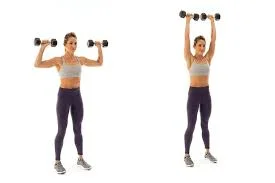
- Take a suitable weight for your needed number of repetitions.
- Lift each weight upward and allow the dumbbells to sit on the shoulders or just over and your palms should be facing in the forward direction.
- Press the weight up above the head and the dumbbells should come closer above the head.
- After that, drop the weight back down until the dumbbells come back on the shoulder.
- Ensure you do full repetitions from all the way upward and back downward.
- The bigger the range of motion, the more the muscle fibers are put to work, resulting in more muscle growth in the shoulders.
- Do again these steps for your selected number of repetitions and sets.
- Try to maintain the weight the same during whole your workout.
A common error some people make while performing a dumbbell shoulder press is taking weights that are too heavy. Because the shoulder is a movable joint, trying to do very heavy low reps is not a smart idea. This is due to the shoulder joint having to work more to stabilize the arm, which increases the chance of injury.
Dumbbell front raise
The dumbbell front raise is the best exercise for building shoulder mass. It is an isolation exercise that majorly focuses on the front head of the shoulder. Because greater weight is applied to a specific portion of the body during isolation exercises, you might have to use lesser weights.
Because a smaller weight has been utilized, a larger amount of repetitions can be used, ranging from 10 to 20. One thing to stay away from is having a swing or motion. Every repetition must be controlled, and the shoulder muscles must be engaged to perform the effort.
How to do Dumbbell front raise
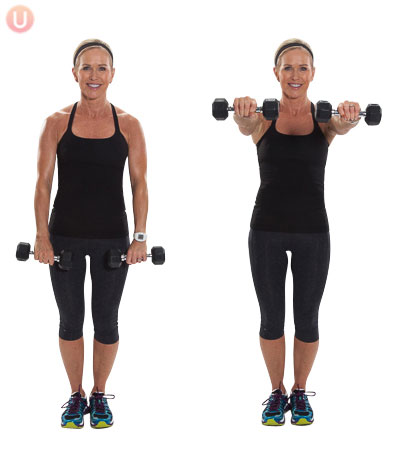
- Start with standing tall with keeping a set of dumbbells against your thighs and your palms should be facing inwards.
- Lift one dumbbell in front of you at a time, so that the dumbbell comes just above your shoulder line.
- Your arm should be almost straight but the elbow soft, palms facing in the direction of the surface of the floor.
- The other arm should be placed against your thigh.
- Keep at the top for a second and drop back down gradually.
- After that lift the opposite arm and do it again in the sequence.
- The goal is for 10 to 15 repetitions per arm.
Dumbbell side lateral raise
The dumbbell side lateral raise works on the side of the shoulders also called the lateral head. This muscle is one that takes part in the most the appearance of shoulder size. The best way to build this muscle is through shoulder abduction which means moving the arm at a distance from the body. For increased repetitions, this exercise works best with moderate to lightweight. It is a difficult exercise to accomplish with large weights, therefore focus on muscular growth instead of maxing out on an excessive load.
This shoulder workout can be performed either seated or standing. The advantage of doing it sitting is that it eliminates the need for lower back support, forcing the shoulders to work more.
How to do dumbbell side lateral raise
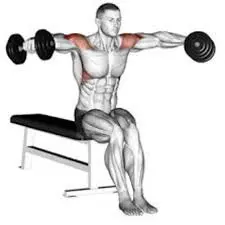
- Take a dumbbell in each hand and sit on a bench and your palms should be facing inwards, next to your thighs.
- Elevate your arms up to the side so that your knuckles are in line with your shoulders and your weights are parallel with the surface of the floor.
- Maintain this position at the top for a second and gradually descend the weight back down to the initiate position.
- Try to keep focus work on your shoulder heads, as otherwise, it is easy for the trapezius muscles to take some of the strain.
- For the standing form of the exercise, stand in the exact same position as for front raises, though with your hands at your sides.
- The goal is for 2 to 3 sets of 12 to 15 repetitions.
Dumbbell bent-over raise
The dumbbell bent-over raise exercise mainly focuses on the posterior delts, placed at the back of the shoulder. For the majority of people, this muscle will be undeveloped compared to the other parts of the shoulder.
However, if you want developed shoulders with lots of muscle mass, keep in mind the posterior delts.
This exercise can be done in either seated or standing positions. The dumbbell bent-over rise, like the front and side raises, can be performed with a lighter weight and more repetitions. It is usual for this muscle to be undeveloped, so do not be surprised if you can’t utilize much weight at first.
How to do dumbbell bent-over raise
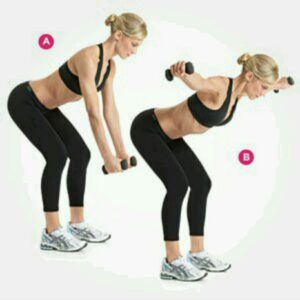
- Keep your back straight and lean over so your torso is almost equal to the floor for the standing variation.
- You should keep your head in a neutral position and avoid extending your neck upwards.
- Your arms should be straight out in front of you, dumbbells in hand, palms facing each other.
- The elbows should not be locked but should be relaxed with a small bend.
- In a reverse fly motion, engage your rear delts and bring your elbows up in the direction of the ceiling.
- With your palms towards the floor, the weights should be near to parallel with the surface of the ground.
- Throughout the movement, maintain your torso still and your core engaged.
- The goal is for 2–3 sets of 12–15 repetitions.
Dumbbell upright row
The dumbbell upright row can be used to work on your shoulders or trapezius, depending on how wide or narrow you maintain your elbows during the movement. The tighter you hold your hands together, the more the exercise develops your traps. The wider you maintain them, the more it benefits the side deltoid muscles.
This is also a complex exercise, therefore greater weights can be employed.
How to do dumbbell upright row
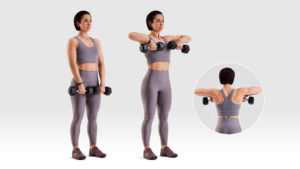
- Take a setup dumbbells and stand up straight with the weights resting on the front of your thighs and your palms should be facing downwards.
- Engage your shoulder muscles raise the hands and elbows in an upward direction, and maintain the palms facing the ground.
- When the muscles are fully engaged at the top of the movement, the weights in your hands should be aligned with your shoulders and pointing forward.
- At the elbow to the shoulder, there should be a nearly 90-degree bend.
- Keep this pose for a second before gently going back to the beginning position.
- Hold the weights closer together inside the thighs to target the traps more effectively.
- The goal is for three sets of eight to twelve repetitions.
Dumbbell shoulder shrugs
This is an excellent way to tone your neck and trapezius muscles. Dumbbell shrugs are an easy exercise to complete, but proper technique and form are essential.
A standard error committed during this exercise is choosing a weight that is overly heavy. Another typical mistake is ignoring one of the most critical parts of the full range of motion training. Dumbbell shrugs can be taught with a wide rep range ranging from 6 to 15 reps.
How to do Dumbbell shoulder shrugs
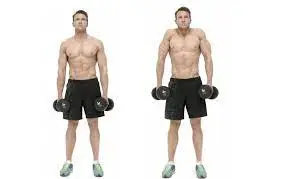
- Grasp a dumbbell in each hand and keep the weights outside the hips, by the side of your thighs.
- Your arms must be in complete extension and your elbows should be relaxed and not locked out.
- Elevate the dumbbells as high as you can with your trapezius by shrugging your shoulders up in the direction of your ears.
- keep for a second before dropping them back down to the initiate position.
- Do not push your head forward.
- This is a standard error, but it shortens the movement and makes it less effective.
- Engage your core muscles and do it again.
- The goal is for 2 to 3 sets of 8 to 12 repetitions.
One-arm dumbbell swing
This exercise is very similar to kettlebell swings but it uses one dumbbell. The benefit here is the extra calories this will burn by raising your heart rate.
How to do a One-arm dumbbell swing
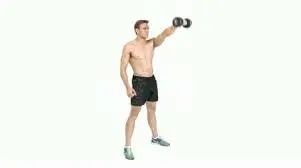
- Keep a dumbbell at arm’s length between your legs.
- Squat and swing the dumbbell between your legs before pressing forward.
- lifting the dumbbell up near your head while you straighten your legs.
- Do again this movement, then switch sides.
Spellcaster
A motion that will concentrate on various areas. It will not only raise your heart rate, but it will also enhance your shoulder flexibility with the rotating action, as well as develop strength and size.
How to do Spellcaster
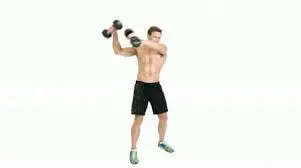
- Keep a dumbbell in either hand.
- Start in standing and your legs should be wide, knees should be slightly bent.
- Swing both dumbbells to one side and raise them to form a full circle from hip level to over the level of the shoulder.
- Swing the weights to the opposite side, descending them towards your hip before lifting them again.
- Repeat in the same way.
See Saw Press
Since they are not both above your head at the same time, the double kettlebell see-saw press enables you to work with heavier kettlebells overhead. The exercise covers your complete upper body while helping in the development of structural integrity.
How to do See Saw Press
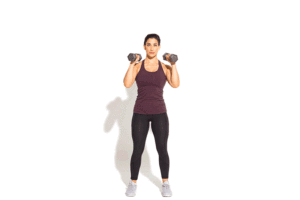
- Grasp two dumbbells just behind your shoulders, palms should be facing in the forward direction.
- Look up and stretch your right arm straight over you, tilting your body to the left.
- To make a see-saw motion, lower the dumbbell and do it again on the opposite side.
- One repetition is equal to doing the motion with both arms.
Leaning dumbbell lateral raise
The dumbbell lateral raise with a leaning helps to increase stability and range of motion by raising the distance your arm must travel when performing the lateral lift.
This increased range of motion combined with a powerful contraction of the lateral deltoid results in higher tension and gains than the standing or seated variations.
Unilateral lateral rises can assist in minimizing strength imbalances between sides.
How to do Leaning dumbbell lateral raise
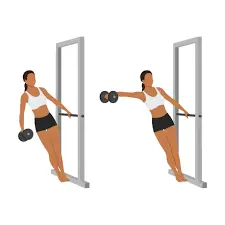
- Grasp a power rack or a pole with one hand and place your feet close to the rack.
- Your dumbbell resting on your outer thigh lifts the dumbbell at a distance until you feel a strong contraction in your lateral deltoid muscles.
- Gradually drop down and do it again for several repetitions.
- After that perform it again on the other side.
one arm bent over the rear delt raise
The stability of one arm bent-over rear delt raise is the best exercise to focus the posterior deltoid, as well as the muscles of the upper back.
You will be able to use more weight and strengthen muscle imbalances between sides with the extra stability of gripping the squat rack. This is beneficial to your shoulders and upper back.
How to perform the stability one arm bent over the rear delt raise:
- Start with standing on one side on a squat rack or something solid gripping a dumbbell in the other hand.
- Grasp the squat rack and lower at the hips maintain your shoulders down and chest up.
- Perform a rear delt raise with a slight bend in the working elbow til you experience a contraction in your upper back and shoulder.
- Go back to the initiate position and do it again for a few repetitions.
- Perform the whole process on the other side.
Dumbbell pullovers
The dumbbell pullover is used for the chest, lats, and serratus anterior. However, in addition to working the upper back and lats, it also trains the posterior deltoid through shoulder extension and the anterior deltoid through shoulder flexion.
When executed correctly, the dumbbell pullover moves your upper body through a wide range of motion, increasing your muscle-building potential. This is a classic bodybuilding move that hits all the right buttons.
How to do dumbbell pullovers:
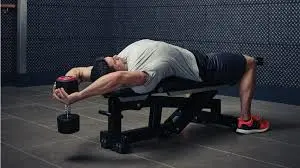
- Start with lying perpendicular on a flat bench, upper body on the bench, and keeping a dumbbell in both hands over your chest.
- Placed your lower body in the hip extension position.
- Engage your glute muscles to maintain your lower back in the neutral position.
- With your elbows slightly bent, let the dumbbell travel backward behind your head as long as you experience a stretch in your pectoralis and latismus muscles.
- Bring the dumbbell back toward your chest once it is behind your head.
- Hold for a second reset and do it again for several repetitions.
External rotation with dumbbell
This exercise mainly focuses on the Shoulders (deltoids) and rotator cuff muscles. Shoulder stabilization workouts like this one are best for improving shoulder health and strengthening the muscles that work in stabilizing the shoulder joint, specifically the rotator cuff muscles.
How To Do External Rotations
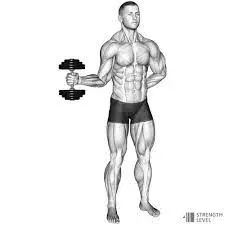
- begins with standing, feet hip-width distance, knees should be slightly bent, and core muscles must be engaged.
- Take a light dumbbell in your right hand.
- Keep the dumbbell near your left hip, your right elbow should be bent at a 90-degree angle, and your upper arm must be near your body.
- The palm must be directed in the direction of your body.
- Shoulder blades are pulled backward and downward.
- Maintain your elbow bent and your upper arm stable, gradually turn your forearm and the dumbbell at a distance from your body.
- Do the rotation until the dumbbell is in front of your shoulder, or you experience a stretch in your shoulder.
- Every person’s range of motion will differ.
- Then gradually and with control, take the dumbbell back to the initiate position, keeping a 90-degree bend in your right elbow.
Dumbbell Punches
This exercise focuses on the Shoulders, triceps, upper back, mid-back, abs, and core muscles.
How To Do Dumbbell Punches
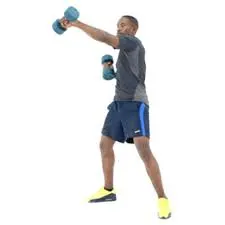
- Start with standing, feet shoulder-width distance, and keep a dumbbell in each hand.
- Elbows should be bent at 90 degrees and palms should be facing towards each other.
- Punch each dumbbell forward a few inches before coming back to the center.
Modification: The further you press the weights at a distance from your body, the more challenging this exercise becomes.
Single Arm Half Kneeling Arnold Press
This exercise mainly targets All three heads of the deltoids, also known as your shoulder muscles.
The kneeling form of the famous Arnold Press takes away any lower-body support and increases upper-body focus.
How To Do Single Arm Half Kneeling Arnold Presses
- Start with a half-kneeling position.
- Feet should be shoulder width at a distance, right knee on the floor, and left foot planted on the surface of the floor.
- Shoulders are maintained over hips.
- Take one dumbbell in your right hand in front of your face at eye height, your palm should be facing towards your face.
- Engage your core muscles and compress your glutes to protect your lower back as you gradually lift the weight in your right hand overhead.
- As you lift the dumbbell, turn your wrist so that the palm of your hand is facing outward (a distance from the body) and your arm should be in full extension.
- Maintain it, then gradually reverse the movement, rotating your wrist as you lower the dumbbell to come back to the initiate position, the palm should be facing towards your body.
Modification: Do this exercise from a standing position if sitting in a kneeling position is not comfortable.
Single Arm Half Kneeling Hinge and Shoulder Press exercise
This exercise focuses on the back deltoids front deltoids (shoulders) and core.
This is the best exercise to raise unilateral (single-sided) demands of stability and strength on the shoulder muscles.
How To Do Single Arm Half Kneeling Hinges and Shoulder Presses
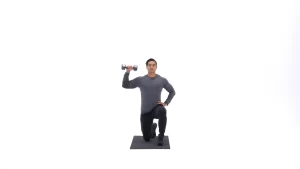
- Begin in a half kneeling position your right knee on the floor and left foot on the floor.
- Take one dumbbell in the right hand with a neutral grip your palm should be facing your body.
- Hinge at the hips with the dumbbell between your legs to do a half-kneeling hinge swing. Then pull your hips forward, bringing the dumbbell up to your right shoulder while keeping your elbow in line with your shoulder (keeping a neutral grip).
- Do a single-arm dumbbell shoulder press from here. Straight overhead dumbbell press, straightening out the elbow, right bicep close right ear.
- Gradually drop the dumbbell back down in the direction of the right shoulder and return to the starting position with the dumbbell between the legs.
Modification: If kneeling is uncomfortable, attempt this exercise from standing.
Deep Swimmer’s Press
This exercise trains the shoulder through a wider range of motion than a standard overhead press, focusing on the frontal head of the deltoid.
How to do Deep Swimmer’s Press
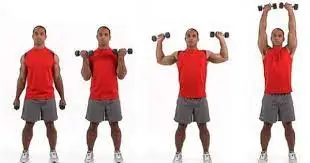
- Start with standing tall with your feet hip-width distance, keeping a pair of dumbbells at your sides, and palms facing forward.
- Maintain your elbows near your sides, and curl the dumbbells up until your elbows are bent at ninety degrees.
- This is the beginning position.
- Curl the weights toward your shoulders, then press them above, twisting your hands so your palms point forward at the top of the movement.
- Reversing the movement, descending the weights as you circle your palms back toward your body, terminating in the half-curl, palms-up position.
- Do the repetitions as needed.
Scarecrow Press
The scarecrow press is a shoulder press variation that is effective for challenging your rotator cuff musculature.
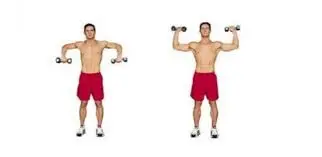
How to do Scarecrow Press
- keeping a dumbbell in each hand, imagine a staggered stance, and lift your arms out to your sides with your elbows bent 90 degrees.
- Your upper arms should be parallel to your shoulders, and your hands are supposed to point upward toward the ceiling.
- This is the beginning position.
- Place your forearms together in front of you, and then reverse the movement to go back to the initiate position.
- Press the weights directly above your shoulders, and then reverse the movement to go back to the initiate position.
- That is one repetition.
Alternating Lunge With Lateral and Front Raise
This complex maneuver is an excellent total-body workout. The lateral raise works your deltoids and traps, whereas the front raise works your anterior deltoids. As you twist and lunge, you will also be exercising your core and smashing your quads and glutes.
How to do Alternating Lunge With Lateral and Front Raise
- Start with standing your feet shoulder-width distance and your arms at your sides, keeping a dumbbell in each hand.
- Maintaining your back flat and your core muscles engaged, lift your arms straight in front of your chest, palms facing each other.
- Descend your arms, rotate to the left, and descend yourself into a lunge stance (rear knee bent ninety degrees, front thigh parallel to the ground) while raising your arms out to your sides, palms facing downward.
- Drop the weights as you stand back up, and then pivot back to the center to go back to the initiate position.
- Do it again this entire sequence, this time pivoting to your right.
- Continue switching sides.
Deadlift
How to do Deadlift

- Start with standing and your feet hip-width distance.
- Your arms should be in full extension and palms facing inward, keep the dumbbells at your sides.
- Dumbbells should be held along the sides of your leg as you engage your core and lower in the direction of the surface of the ground.
- You can lower your torso and bend your knees by concentrating on pressing your butt back. While doing so, keep your spine neutral.
- Push your hips forward at the height of the movement to stand up by pushing through your heels when the dumbbells reach your ankle.
- Do It Again.
- Deadlifts improve the muscles responsible for holding the torso upright—the lower back, glutes, and core. They target the hamstrings and quadriceps in the lower body as well as the muscles along the spine.
FAQ
What are some shoulder exercises that can be done with dumbbells?
Some shoulder exercises that can be done with dumbbells include dumbbell shoulder press, lateral raises, front raises, upright rows, and bent-over lateral raises.
How many sets and reps should I do for shoulder exercises with dumbbells?
Depending on your fitness level and goals, the number of repetitions and sets can vary. It is generally recommended to begin with 2-3 sets of 8-12 repetitions for each exercise. As you grow, you can increase the number of sets or repetitions to keep your muscles challenged.
How frequently should I perform dumbbell shoulder exercises?
It is generally suggested that you rest your muscles for at least 48 hours between workouts.
Therefore, you can perform shoulder exercises with dumbbells 2-3 times per week, allowing for adequate recovery time.
What weight should I use for shoulder exercises with dumbbells?
The weight you use for shoulder exercises with dumbbells should be challenging but manageable. Start with a weight that enables you to correctly do the appropriate number of reps. If the exercise feels too easy, you can gradually increase the weight.
Are there any precautions I should take when doing shoulder exercises with dumbbells?
Yes, it is important to use proper form and technique to avoid injury. Begin with lesser weights and concentrate on keeping control throughout the exercise. Stay away from swinging the weights or using momentum. If you have any pre-existing shoulder conditions or injuries, it is recommended to consult with a healthcare professional before starting any new exercise routine.
References
- Set, S. F. (n.d.). The Ultimate Dumbbell Shoulder Workout. SET FOR SET. https://www.setforset.com/blogs/news/dumbbell-shoulder-workout
- Rathod, K. (2023, August 2). Dumbells Back Exercise To Improve Strength And Posture. Samarpan Physiotherapy Clinic. https://samarpanphysioclinic.com/dumbells-back-exercise-to-improve-strength-and-posture/#Deadlift
- Smith, P. (2023, April 28). 14 Best Shoulder Exercises You Can Do at Home. BODi. https://www.beachbodyondemand.com/blog/shoulder-workouts-at-home#:~:text=Stand%20tall%20with%20your%20feet%20hip%2Dwidth%20apart%20and%20your,arms%2C%20and%20repeat%20for%20reps.
- Cpt, L. B. (2023, September 20). 7 Best Shoulder Exercises (25-Minute Dumbbell Shoulder Workout For Women). Nourish, Move, Love. https://www.nourishmovelove.com/best-shoulder-exercises-for-women/
- Williams, D., & Williams, D. (2023, June 5). Shoulder Workout With Dumbbells At Home for Lean Muscle | A Lean Life. A Lean Life. https://www.aleanlife.com/shoulder-workout-with-dumbbells-at-home/
- Top Dumbbell Shoulder Exercises | Shoulder Workouts for Mass – MYPROTEINTM. (2022, May 6). MYPROTEINTM. https://www.myprotein.co.in/blog/training/shoulder-training-dumbbell-exercises-mass/
- Image: Seated Dumbbell Side Lateral Raises. (n.d.). skimble.com. https://www.skimble.com/exercises/72756-seated-dumbbell-side-lateral-raises-how-to-do-exercise
- Image: Half Kneeling Single Arm KB Press | Functional Movement Systems. (n.d.). https://www.functionalmovement.com/exercises/465/half_kneeling_single_arm_kb_press
- Image: Dumbbell Punches. (n.d.). skimble.com. https://www.skimble.com/exercises/69547-dumbbell-punches-how-to-do-exercise
- Image: Dumbbell External Rotation Standards for Men and Women (kg) – Strength Level. (n.d.). Strength Level. https://strengthlevel.com/strength-standards/dumbbell-external-rotation/kg
- Image: Warner, J. (2022, March 22). Do the dumbbell pullover to build a bigger chest. New Body Plan. https://www.newbodyplan.co.uk/training/back/move-masterclass-the-dumbbell-pullover/
- Image: Putra, L. (2023, August 8). Download the Woman doing leaning one arm or single-handed dumbbell lateral raise exercise. 26751946 royalty-f. . .. Vecteezy. https://www.vecteezy.com/vector-art/26751946-woman-doing-leaning-one-arm-or-single-handed-dumbbell-lateral-raise-exercise
- Image: Spellcaster. (2023, May 12). Men’s Health. https://www.menshealth.com/uk/fitness/a753070/spellcaster/
- Image: One-arm dumbbell swing. (2023, May 12). Men’s Health. https://www.menshealth.com/uk/fitness/a753056/one-arm-dumbbell-swing/
- Image: Neudecker, K. (2023, March 3). Nail the Dumbbell Shrug for Bigger, Broader, Boulder Shoulders. Men’s Health. https://www.menshealth.com/uk/fitness/a753510/dumbbell-shrug/
- Image: Single-arm half-kneeling shoulder press | Exercise Videos & Guides | Bodybuilding.com. (n.d.). Bodybuilding.com. https://www.bodybuilding.com/exercises/half-kneeling-dumbbell-shoulder-press
- Image: How to do Arnold Press: Variations, Proper Form, Techniques, Dumbbell. (2023, July 19). Athletic Insight. https://www.athleticinsight.com/exercise/shoulder/press/arnold
- Image: K. (2015, April 13). Scarecrow Rotation. Bodybuilding Wizard. https://bodybuilding-wizard.com/scarecrow-rotation/

